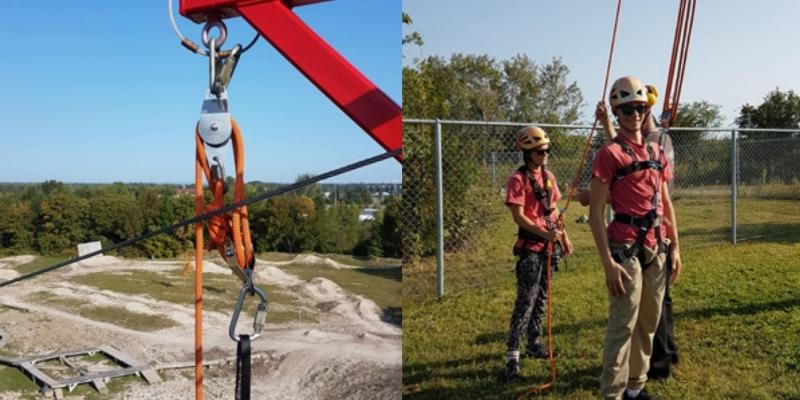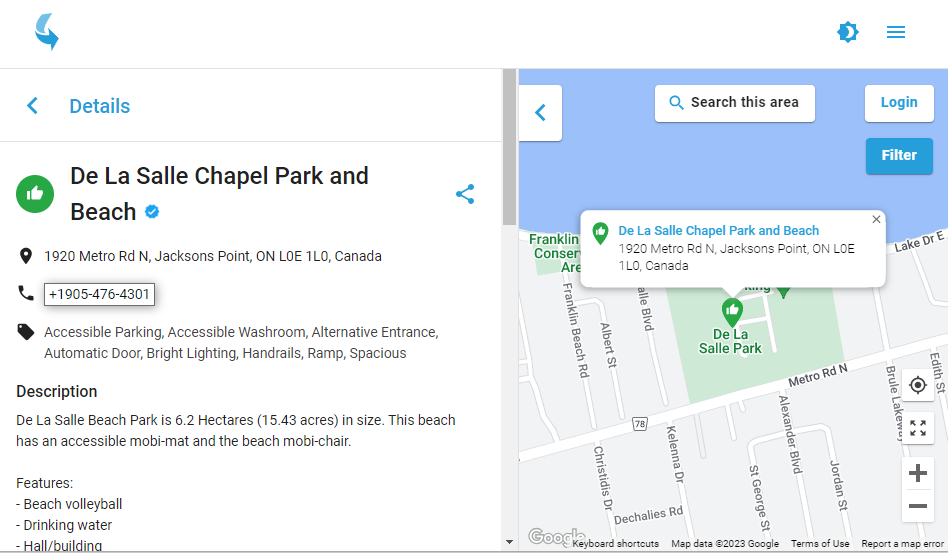The Town of Georgina is committed to providing all members of the public and its employees with an environment of inclusive design and integration through continuing policy development in our services, products and facilities. Visit the Accessibility Inclusion page to learn more about the accessible programs at the Town. Find out about the accessibility features at Town facilities.
On Aug. 13, 2025, Council approved the Georgina Multi-Year Accessibility Plan 2025-2029. The plan was informed by broad community consultation and feedback from accessibility stakeholders.
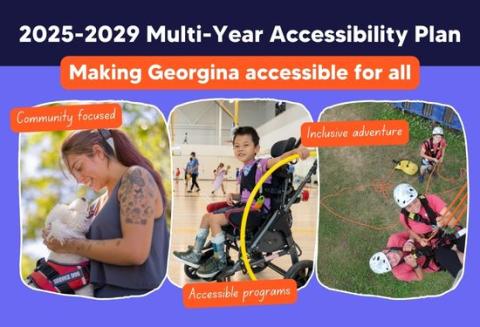
Accessibility standards and best practices
What is accessibility?
All Canadians have the right to take part fully in society. Advancing accessibility is about creating barrier-free communities, workplaces and services for all Canadians.
What is a disability?
Disability is defined by the World Health Organization (WHO) (opens in a new tab) as the temporary, prolonged or permanent reduction or absence of the ability to perform certain commonplace activities or roles, sometimes referred to as activities of daily living.
In 2022, 27 per cent of Canadians aged 15 and over, or eight million people, had at least one disability.
The Rio 2016 Paralympics released a video called "We're the Superhumans" (opens in a new tab) that showcases how people with disabilities do amazing things.
Contact us
We want to hear from you. Is there an accessibility issue you have seen in the Town? Contact Service Georgina by email or by phone at 905-476-4301, ext. 3001.
The Town of Georgina is committed to providing accessible formats and communications supports for people with disabilities.
Ontario’s legislative, regulatory and policy context
Ontario Human Rights Code (OHRC) and Ableism Policy
Ontario Human Rights Code and disability rights
The Ontario Human Rights Code (opens in a new tab) has “primacy,” meaning most Ontario laws must follow it. The Code protects people from discrimination and harassment based on disability in areas such as employment, services, goods, facilities, housing, contracts and membership in trade or vocational associations. This includes the right to accessible workplaces, schools, transit, services, shops, restaurants and housing.
The Code also requires organizations to prevent and address discrimination, whether direct or indirect, and to maintain inclusive, accessible and harassment-free environments.
Ableism and the OHRC policy
“Ableism” refers to attitudes or systems that devalue or limit people with disabilities. It may be conscious or unconscious, and can be embedded in institutions, policies or cultural norms.
The Ontario Human Rights Commission’s Policy on ableism and discrimination based on disability (2016) (opens in a new tab) provides guidance to help organizations meet their obligations under the Code. It covers:
- Understanding rights and responsibilities under the Code
- Designing facilities, policies and procedures inclusively
- Responding to accommodation requests
- Addressing disability-related complaints
- Accessing further resources
Accommodation requirements
Organizations must design inclusively, remove barriers and respond to individual accommodation requests unless doing so would cause undue hardship. The most appropriate accommodation:
- Respects dignity
- Meets individual needs
- Supports integration and full participation
Accommodation is about meeting needs, not preferences. If multiple options meet the same need, the provider may choose the less costly or less disruptive option. The process is a shared responsibility between the person requesting and the provider.
At the Town of Georgina, policies, practices, training and accommodations in employment, services, facilities, housing and contracts are informed by the Code and the OHRC policy.
Accessibility for Ontarians with Disabilities Act (AODA)
In 2005, the Government of Ontario passed the Accessibility for Ontarians with Disabilities Act (AODA) (opens in a new tab), which aims to make Ontario fully accessible by 2025. The AODA establishes a process for creating and enforcing accessibility standards, which all levels of government, businesses, non-profits and public sector organizations must follow.
Accessibility standards benefit people with temporary or permanent disabilities, as well as others. For example, an automatic door designed for a person with a disability also helps a parent with a stroller or someone carrying items.
AODA standards
The Integrated Accessibility Standards Regulation (IASR) (opens in a new tab) under the AODA sets five key areas to identify and remove barriers:
- Customer service
- Came into effect Jan. 1, 2008, with phased requirements for public and private sectors.
- Requires policies that respect dignity, independence, integration, equal opportunity and effective communication.
- Organizations must train staff and volunteers, provide a process for feedback, and allow service animals and support persons.
- Information and communications
- Requires accessible formats and communication support on request.
- Covers websites, web content, educational and training materials, libraries and public-facing resources.
- Designated public sector and large organizations must meet WCAG 2.0 Level AA standards by Jan. 1, 2021.
- Employment
- Supports accessibility throughout the employment lifecycle.
- Requires accessible recruitment, accommodation for applicants, accessible work information, customized emergency procedures, and individual accommodation plans.
- Also covers return-to-work, performance management, career development and redeployment.
- Transportation
- Applies to conventional and specialized transportation services.
- Covers accessibility planning, equipment, training, announcements, fares, seating, and mobility aid storage.
- Municipalities must ensure accessible taxicabs; school boards and public sector organizations must meet transportation requirements.
- In Georgina, regional transit accessibility is covered by the Region of York’s Accessibility Plan.
- Design of public spaces (built environment)
- Applies to new or redeveloped public-use areas.
- Covers recreational trails, beach access, outdoor tables, play spaces, sidewalks, parking, waiting areas, service counters and queuing guides.
- Focuses on areas not covered by the Ontario Building Code; retrofitting is not required.
General provisions
The IASR also includes rules on accessibility policies, multi-year accessibility plans, procurement, self-service kiosks and staff training.
As of July 1, 2016, the Customer Service standard was incorporated into the IASR, creating a single, easier-to-follow regulation. If AODA standards conflict with the Ontario Human Rights Code, the Code’s requirements take precedence.
The Ontario Building Code (OBC)
Ontario Building Code and accessibility
In addition to the AODA’s Design of Public Spaces standard, accessibility requirements are included in Ontario’s Building Code (OBC) (opens in a new tab), which has included barrier-free design rules since 1990. The OBC regulates most aspects of building and structure construction in Ontario.
Enhanced accessibility standards
Since Jan. 1, 2015, the Building Code has included updated accessibility requirements for most new construction and major renovations. Key updates include:
- Visual fire and smoke alarms
- Elevator access between floors in most buildings
- Barrier-free paths of travel inside buildings, including power doors at entrances
- Minimum number of visitable apartment suites increased from 10% to 15%
The Building Code does not apply to existing buildings where no work is planned, and most requirements do not affect single-family homes.
Other jurisdictions
Legislation from other jurisdictions may sometimes provide helpful insights into accessibility/inclusion issues in Ontario. The Government of Canada, several other Canadian provinces and the United States have taken steps to implement accessibility/inclusion legislation as indicated below:
- Federal Government of Canada:
- The Accessible Canada Act: An Act to Ensure a Barrier-free Canada, 2019
- The Canadian Charter of Rights and Freedoms
- The Canadian Human Rights Act
- The Employment Equity Act
- Standard on Web Accessibility
- Provincial:
- The Accessibility for Manitobans Act, 2013
- Nova Scotia Accessibility Act, 2017
- Quebec's Act to Secure Handicapped Persons in the Exercise of their Rights with a View to Achieving Social, School and Workplace Integration, 2004
- Accessible British Columbia Act, 2021
- United States
- Americans With Disabilities Act, 1990/2008
Best practices
Beyond minimum compliance
Ontario’s accessibility laws set minimum standards, but the Town of Georgina aims to go beyond the letter of the law. Following best practices helps create a more inclusive community for everyone.
The Town actively shares and learns best practices with accessibility partners, including York Region, other local municipalities, and members of the Ontario Network of Accessibility Professionals (ONAP). The international accessibility and inclusion community also provides innovative ideas, practices and technologies.
Georgina’s accessibility leadership, governance and resources
Accessibility statement – Mayor and Council
The Town of Georgina is dedicated to fostering a community that is open, inclusive and accessible to all residents and visitors. We want to ensure our public facilities, parks and buildings meet the highest accessibility standards, and our community services and programs are designed to be inclusive, allowing everyone to fully participate. We incorporate accessibility considerations into all municipal policies and development plans to promote equality, and actively seek input from residents with disabilities to ensure their voices guide our accessibility initiatives. Continuous education for staff and Council on accessibility issues fosters an inclusive mindset in all municipal functions. By prioritizing these areas, Georgina is working towards being a community that respects and values the contributions and participation of every individual.
The Georgina Accessibility Advisory Committee (GAAC)
Under the AODA, municipalities with populations of 10,000 or more must establish an accessibility advisory committee.
The Georgina Accessibility Advisory Committee (GAAC) advises the Town on strategies to create and maintain a barrier-free community. The committee meets up to eight times a year, usually skipping January, July, August and December.
GAAC is highly active both during and between meetings. Members raise awareness, develop and implement accessibility policies, provide advice on projects, and review site plan applications.
The committee has seven volunteer members appointed by Council, including two Council members and five citizens. The majority of citizen members have one or more disabilities. Members are selected for their commitment to inclusion and their expertise in accessibility.
Town staff support GAAC through a temporary Accessibility Advisor who leads the renewal of the Multi-Year Accessibility Plan (MYAP) and supports both GAAC and the Accessibility Staff Team (GAST). Each year, GAAC presents its annual report and business plan to Council, highlighting accessibility concerns and improvement opportunities. Copies of GAAC’s annual report, work plan, and the Town’s five-year accessibility plan are posted on the website.
The Government of Ontario has provided a great resource guide to members of the GAAC.
The Georgina Accessibility Staff Team (GAST)
The Accessibility Staff Team (GAST) provides professional expertise and technical support to the Town and the GAAC. GAST ensures interdepartmental cooperation and accountability in advancing accessibility initiatives.
Roles and responsibilities
GAST representatives:
- Help identify, remove and prevent barriers for people with disabilities
- Develop work plans for their areas of responsibility
- Attend GAAC meetings as required
The team meets monthly, up to 10 times a year, to discuss accessibility issues and provide updates on the Town’s facilities, programs, services and initiatives.
During the development of the Five-Year Accessibility Plan (2023–2027), GAST reviewed all AODA legislative requirements and accessibility standards. Members worked with other staff to develop action plans to meet or exceed these requirements.
As the Plan is implemented, GAST monitors progress, reviews updates to legislation and standards, and considers recommendations from GAAC and community stakeholders to inform necessary updates or improvements to the Plan.
GAST membership
The team includes representatives from across the Town:
- Accessibility Advisor
- Communications
- Economic Development
- Parks Development and Operations
- Recreation Services
- Operations and Infrastructure
- Development Services
- Strategic Initiatives
- Facilities
- Procurement
- Service Georgina
- Municipal Law Enforcement
- Clerks
- Fire and Rescue Services
- Human Resources
Accessibility partners, stakeholders and advocates
The Town of Georgina’s Accessibility Team is a member of the Ontario Network of Accessibility Professionals (ONAP) (opens in a new tab) , a community of about 270 public sector accessibility professionals who work together to remove barriers across municipalities, hospitals, universities, colleges and other public sector organizations.
Town staff also collaborate with York Region and the eight area municipalities to identify and remove barriers and share best practices.
The Town participates in a range of partnerships and networks focused on accessibility and inclusion, including:
- York Region and its tier-two municipalities (opens in a new tab)
- Ontario Network of Accessibility Professionals (ONAP) (opens in a new tab)
- Whitby Abilities Centre LEAD Program (opens in a new tab)
- Board of Trade
- Georgina Chamber of Commerce (opens in a new tab)
- March of Dimes (opens in a new tab)
- Ontario Ministry for Seniors and Accessibility (opens in a new tab)
- Georgina Public Library
- Various community stakeholder groups
Accessibility features of Georgina facilities
The full list of beaches, parks and facilities you can see the accessible features of Town facilities.
See specifics about inclusion and support in the Town.
Click the AccessNow map image below to view the accessibility of Town Facilities, Parks and Beaches.
Community consultation and feedback process
The Town developed its next multi-year accessibility plan following broad consultation with the community. For more information, contact Service Georgina by email or by phone at 905-476-4301, ext. 3001.
2024 approved capital budget and 2024 to 2027 capital forecast
This website section is under construction. Check back for more information.
Accessibility planning
Overview
Context and demographics
Compared with other jurisdictions in Canada and internationally, Ontario has established a comprehensive legal and policy framework aimed at achieving an inclusive and fully accessible province and addressing ableism.
Ableism refers to attitudes in society that devalue and limit the potential of persons with disabilities. It may be conscious or unconscious and can be embedded in institutions, systems, or the broader culture. Ableism sees persons with disabilities as less worthy of respect and consideration, less able to contribute, or of less inherent value than others. It can limit opportunities and reduce inclusion in community life.
Since 2012, the Canadian population aged 15 and over with disabilities has grown from 3.8 million to 6.2 million. The disability ratio has also increased, from 14 per cent in 2012 to 27 per cent in 2022. Economically, 22.3 per cent of Canada’s 15.2 million households include at least one member living with a disability, with household consumer spending exceeding $200 billion.
In Georgina, this translates to approximately 10,000 people living with one or more disabilities. As the population ages, the ongoing impacts of the COVID-19 pandemic are realized, and economic pressures contribute to additional mental health challenges, the percentage of residents with disabilities is expected to continue increasing through 2025 and beyond.
Challenges and human rights
Despite Ontario’s leadership in accessibility and inclusion, people with disabilities continue to face barriers to employment, housing, and various services. Statistics Canada reports that Ontarians with disabilities have lower educational attainment, higher unemployment, are more likely to have low income, and are less likely to live in adequate, affordable housing compared with those without disabilities. Disability is also the most frequently cited ground of discrimination under the Ontario Human Rights Code in claims brought to the Human Rights Tribunal of Ontario.
Accessibility planning in Georgina
The Town of Georgina has completed the Multi-Year Accessibility Plan for 2018–2022 and is now implementing the Five-Year Accessibility Plan 2025–2029. The plan was developed in consultation with residents living with disabilities, other accessibility stakeholders, and the GAAC. Themes such as the ongoing effects of the COVID-19 pandemic, economic challenges, and anticipated municipal growth set the stage for accessibility planning in Georgina over the next five years.
Georgina Multi-Year Accessibility Plan 2025-2029
The Town has completed the development of the Georgina Multi-Year Accessibility Plan for 2025–2029. The plan was informed by broad community consultation and feedback from accessibility stakeholders.
The GAAC continues to monitor the Town’s progress on the plan. Each spring, GAAC presents year-end reports and work plans to Council, providing an objective assessment of accessibility initiatives and keeping Council informed of emerging accessibility issues and priorities.
View the digital version of the Georgina Multi-Year Accessibility Plan. A printable version of the plan is coming soon.
The Georgina Five-year Accessibility Plan for 2018-2022
The Georgina Five-Year Accessibility Plan for 2018–2022 was successfully completed. During its implementation, GAAC monitored progress and, each spring, presented year-end reports and work plans to Council. These reports provided an objective assessment of accessibility initiatives and kept Council informed of emerging accessibility issues and priorities.
Briefing note to Georgina Accessibility Advisory Committee- February 2024
Accessibility environmental scan
To inform the priorities and content of the 2025–2029 plan, the Town conducted a comprehensive scan of Georgina’s accessibility environment. Input was gathered from the Georgina Accessibility Advisory Committee (GAAC), the Georgina Accessibility Staff Team (GAST), persons with disabilities in the community, the Ontario Network of Accessibility Professionals (ONAP), and other local accessibility stakeholders.
The scan identified a number of factors likely to shape accessibility in Georgina through 2029, including:
Demographics
Since 2012, the Canadian population aged 15+ with disabilities grew from 3.8 million to 6.2 million. The disability ratio increased from 14 per cent in 2012 to 27 per cent in 2022. In Georgina, this represents approximately 10,000 residents living with one or more disabilities. An aging population and the long-term impacts of COVID-19 are expected to increase this number.
AODA Reviews
- 2019 Review: The Honourable David C. Onley’s review of the Accessibility for Ontarians with Disabilities Act (AODA) found that Ontario remained full of barriers for people with disabilities and recommended improvements to accessibility legislation and practices.
- 2023 Review: Rich Donovan’s fourth independent review of the AODA highlighted that Ontario will not achieve a fully accessible province by 2025. Key concerns included poor outcomes, weak enforcement, limited data, a lack of urgency, and insufficient accountability. Recommendations were made in three categories: crisis (immediate safety measures and agency creation), strategic (alignment with federal accessibility regulations), and tactical (research, data collection, and policy guidance).
COVID-19 Impacts
The pandemic had lasting effects on accessibility in Georgina, including increased physical and mental health challenges, social isolation, financial uncertainty, and the emergence of new disabilities. It also accelerated the adoption of accessibility-supporting technologies such as videoconferencing, real-time captioning, translation tools, and artificial intelligence applications.
Research and Community Feedback
Post-pandemic research identified ongoing barriers to recreation, social participation, and physical activity for priority populations. Surveys show widespread support for accessibility:
- 91 per cent of Canadians say underemployment due to workplace barriers is unacceptable.
- 40 per cent of people with disabilities feel companies fall short in hiring, rising to 55 per cent for those aged 18–34.
- 92 per cent agree that taxpayer-funded projects should meet the highest accessibility standards.
Other Influences
The plan also considered private sector innovation, emerging adaptive technologies, lessons from other jurisdictions (including U.S. accessibility standards), and collaboration through ONAP and York Region municipalities.
Purpose of the 2025–2029 Plan
The 2025–2029 Five-Year Accessibility Plan provides a roadmap for Council and staff to prevent, reduce, and, where possible, eliminate barriers in Town facilities, programs, and services. It also outlines how the Town will meet its obligations under the Ontario Human Rights Code, the AODA, and the Ontario Building Code. This plan builds on the successful completion of the 2018–2022 plan and represents Georgina’s continued commitment to exceeding minimum compliance and pursuing best practices in accessibility.
Accessibility vision for the Town of Georgina - 2025-2029
Georgina: a growing, inclusive community
Georgina is a smaller but fast-growing Town within York Region, with a population of 47,642. The Town’s Strategic Plan supports significant economic and residential growth while maintaining an excellent quality of life for those who live, work, and play here. Georgina is a popular destination for outdoor events and unique recreational experiences, at the heart of a vibrant, inclusive, and engaged community.
Municipal services and programs
The Town provides a wide range of services, including:
- Maintenance of municipal infrastructure
- Planning and development
- Economic development
- Municipal law enforcement
- Inclusive cultural and recreational programs
Georgina is committed to making the community an attractive place to live, work, and invest. The Town offers top-quality recreation facilities and programs, including:
- Indoor and outdoor recreation assets
- Multi-Use Recreation Complex (MURC)
- Museum and libraries
- Community and neighbourhood parks, beaches, conservation areas, waterfront facilities, and hiking trails
Staff and facilities
The Town employs staff to meet the needs of residents and operates facilities for library services, fire services, recreation, and community programs.
Accessibility and inclusion
Georgina’s Multi-Use Recreation Complex fully complies with Ontario’s accessibility standards and models best practices in inclusive design. Future programs, events, and services will continue to advance accessibility. The Town aims to be recognized as an Ontario showcase for accessibility and inclusion.
Coordination with other plans
Other Town plans that intersect with accessibility and inclusion are at various stages of development or completion. These plans will be aligned with Georgina’s Five-Year Accessibility Plan 2025–2029 and include:
- Recreation initiatives
- Age-friendly programs
- Affordable and accessible housing
- Diversity, equity, and inclusion strategies
Georgina’s accessibility priorities - 2023–2027
Long-term vision for accessibility
The Town’s long-term vision is to ensure Georgina is a caring and responsive community, recognized for its commitment to equity, inclusion, and accessibility. With the support of Council, management, staff, the GAAC, volunteers, and a broad range of community partners, barrier removal will remain a priority. Accessibility is everyone’s responsibility and is incorporated by design into the work of all Town departments.
Five-Year Accessibility Plan 2025–2029
The 2025–2029 Five-Year Accessibility Plan includes both new and ongoing initiatives to help Georgina meet its commitment to an inclusive community. The plan ensures that all residents and visitors can access Town services, programs, and facilities in a manner that is integrated, dignified, and promotes independence.
Commitment to accessibility standards and innovation
During 2025–2029, the Town will continue to address the areas of accessibility outlined in the Integrated Accessibility Standards Regulation (IASR). In addition, the Town will consider barriers more broadly and, using best practices and emerging opportunities, seek innovative and inclusive solutions. The Town is committed to going beyond legislated requirements where feasible to identify and address accessibility barriers throughout the community.
Areas of priority
Georgina’s key accessibility priorities include:
- Accessibility of Town facilities, resources, programs, and services
- Accessibility partnerships and collaboration
- Website accessibility
- Mental and physical wellness, including recreation, sports, and access to serene public spaces
- Parks, playgrounds, pedestrian and cyclist corridors, sidewalks, and trails
- Accessible and affordable housing options
- Accessible transportation
- Community employment opportunities for people with disabilities
- Signage and navigation
- Continuous improvements and maintenance of Town facilities, parks, and public spaces
Service disruptions
Any service disruptions affecting accessible features and facilities are listed on the Disruptions and Closures page.
Appendix: Georgina’s accessibility plans and reports
This website section is under construction. Check back for more information.
2025 Accessibility Compliance Report
2023 Accessibility Compliance Report
View agendas, minutes and meeting recordings for the Council and the Georgina Accessibility Advisory Committee (GAAC).
Accessibility learning resources and links
Accessibility Legal Frameworks
Ontario legal framework, standards and policies
- Accessibility for Ontarians with Disabilities Act, 2005, S.O. 2005, c. 11 (ontario.ca) (opens in a new tab)
- Human Rights Code, R.S.O. 1990, c. H.19 (ontario.ca) (opens in a new tab)
- O. Reg. 332/12: BUILDING CODE (ontario.ca) (opens in a new tab)
Federal legal framework, standards and resources
- Government Bill (House of Commons) C-81 (42-1) - Royal Assent - Accessible Canada Act - Parliament of Canada (opens in a new tab)
- About an Accessible Canada - Canada.ca (opens in a new tab)
- Accessibility Standards Canada (opens in a new tab)
- Services for persons with disabilities - Canada.ca (opens in a new tab)
Accessibility guides
- Accessibility in Ontario | ontario.ca (opens in a new tab)
- How to comply with the Integrated Accessibility Standards Regulation | ontario.ca (opens in a new tab)
- AccessForward | ontario.ca (opens in a new tab)
- Guide to Accessible Festivals & Outdoor Events (king.ca) (opens in a new tab)
- Guide to Conducting Accessible Meetings (omssa.com) (opens in a new tab)
- Accessible Engagement - Ontario Municipal Social Services Association (omssa.com) (opens in a new tab)
- 160307102314920_IPC Accessibility Guide.pdf (paralympic.org) (opens in a new tab)
- WCAG 2 Overview | Web Accessibility Initiative (WAI) | W3C (opens in a new tab)
Accessibility partners
- Ministry for Seniors and Accessibility | ontario.ca (opens in a new tab)
- Accessibility | York Region (opens in a new tab)
- Community Hub & Inclusion Incubator | Abilities Centre Whitby (opens in a new tab)
- Kinark Child and Family Services (opens in a new tab)
- Empowering Lives | Canadian Hearing Services (chs.ca) (opens in a new tab)
- Resources | CNIB (opens in a new tab)
- Autism Home Base (opens in a new tab)
- Ontario Disability Support Program | ontario.ca (opens in a new tab)
- Ontario Workinfonet (OnWIN) - Links - Persons With disABILITIES (opens in a new tab)
- NEADS (opens in a new tab)
- Accelerating Accessibility Coalition | ULI Toronto (opens in a new tab)
- Free Digital Accessibility Resources | AbilityNet (opens in a new tab)
- Business of Accessibility Handbook | OBIAA, 2019 (opens in a new tab)
Accessibility photo album
Julia Munro Park
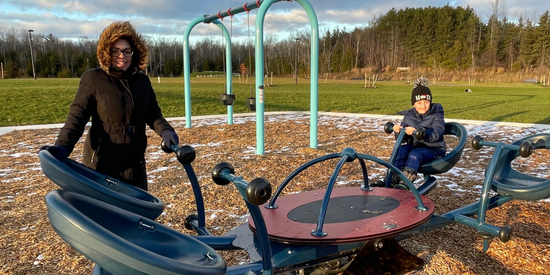
Sledge hockey
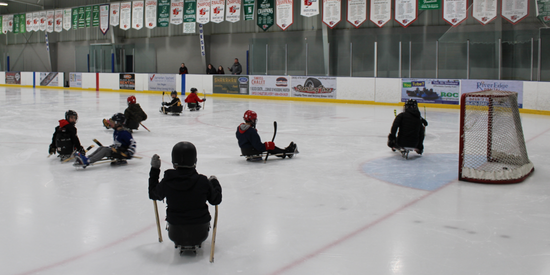
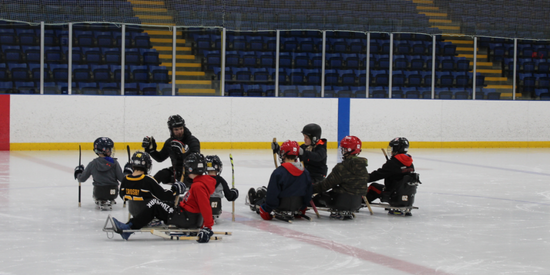
Inclusion swimming lessons

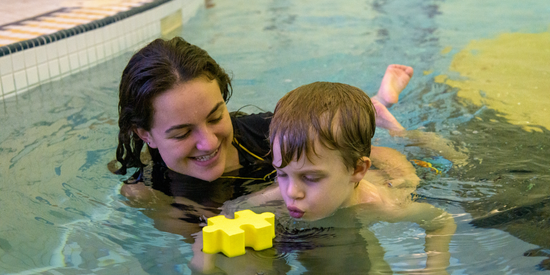
Pool wheelchair at the MURC
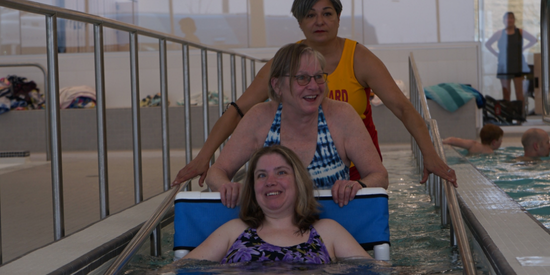
ROC challenge course
